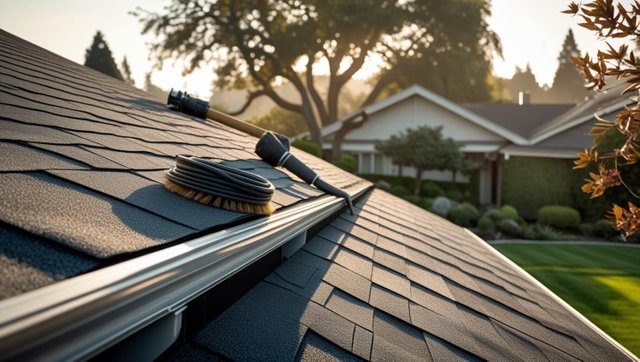Roof Maintenance Tips for North Bay Homeowners: Prevent Problems Before They Start
Your roof doesn’t need constant attention, but it does need care. In Marin, Sonoma, Napa, and San Francisco Counties, homes face wind, salt, heat, rain, and wildfire risk—all of which shorten the life of your roof if ignored.
This article gives you clear, useful steps to protect your investment, reduce long-term costs, and avoid emergency repairs.
Why Maintenance Matters
Most roofing systems last 15 to 50 years depending on material and quality. But without regular maintenance, even the best roof fails early.
Routine care helps you:
Spot small issues before they cause leaks
Prevent mold and wood rot
Extend the life of shingles or membrane systems
Protect insulation and ventilation
Avoid expensive interior damage
Roof replacements cost tens of thousands of dollars in the North Bay. Annual inspections and small fixes cost a fraction of that.
Trusted providers like Wedge Roofing offer inspection services and maintenance plans that match local conditions.
Tip 1: Inspect Twice a Year
Inspect your roof at least twice each year—once in the spring and once in the fall.
What to look for:
Missing or damaged shingles
Exposed nails or flashing
Moss or algae buildup
Cracks in caulking or seals
Rust on vents or metal components
Warped or sagging roof lines
Use binoculars from the ground or hire a professional. Don’t walk on the roof unless you have the proper safety gear and training.
Tip 2: Clean the Gutters
Gutters clog quickly in the fall, especially under oak, redwood, or eucalyptus trees. Clogged gutters cause water to back up under the roofline.
Clean your gutters:
Twice a year minimum
After major storms
More often if you have nearby tree cover
Check that downspouts drain away from the foundation. Consider installing gutter guards to reduce future debris buildup.
Tip 3: Trim Overhanging Branches
Trees near your home create multiple risks.
Problems caused by overhanging limbs:
Leaves and twigs clogging gutters
Shade that encourages moss
Branches rubbing and damaging shingles
Falling limbs during storms
Keep trees trimmed at least 6–10 feet away from the roof surface. This also helps reduce fire risk in WUI zones like Napa and parts of Sonoma.
Tip 4: Watch for Moss and Algae
Moss holds moisture against the roof. Over time, this shortens the life of shingles and damages wood decking underneath.
Control moss with:
Zinc or copper strips installed near the ridge
Low-pressure professional roof cleaning
Clearing shaded areas that stay wet
Avoid power washing. It removes granules from shingles and can void warranties. Let pros like Wedge Roofing handle roof cleaning with safe, approved methods.
Tip 5: Check Attic Ventilation and Insulation
A healthy roof depends on airflow from inside your home, not just weather protection on the outside.
Inspect your attic for:
Blocked vents
Signs of moisture or mold
Rust on nails or metal fasteners
Uneven insulation coverage
Poor ventilation leads to heat buildup in summer and moisture buildup in winter. Both will shorten roof life.
Your contractor can adjust soffit, ridge, or gable vents to keep attic temperatures in range. This matters for both shingle roofs and flat systems in San Francisco homes.
Tip 6: Schedule After-Storm Checks
High winds and heavy rain cause hidden roof damage. After any major storm, inspect or have your roofer inspect.
Check for:
Loose or missing shingles
Bent or detached flashing
Leaks in the attic
Gutter or downspout detachment
Some damage isn’t visible from the ground. If you notice granules on the ground or gutters, schedule a professional evaluation right away.
Tip 7: Keep Roofing Records
Document everything. Your records help during warranty claims, insurance adjustments, or future home sales.
Keep track of:
Installation date and material brand
Warranty info (labor and materials)
All inspection reports
Photos of repairs
Contractor names and invoices
If you ever sell your home, this information increases buyer trust and avoids negotiation headaches.
Tip 8: Don’t Delay Repairs
Small issues turn into major ones fast.
Examples:
A cracked shingle becomes a leak after one storm
A loose flashing leads to wall damage
A clogged downspout causes roof deck rot
Fast, low-cost repairs save thousands in structural or interior damage. Don’t wait for visible stains or ceiling sagging to act.
If your roof is older than 15 years, annual inspections are critical. Wedge Roofing helps North Bay homeowners stay ahead of aging issues and build a timeline for replacement when the time comes.
Tip 9: Know When to Replace
Maintenance won’t fix everything. At some point, repairs no longer make sense.
Time to consider full replacement if:
Roof is over 25 years old (for asphalt)
Leaks keep returning
Shingles are brittle or missing across wide areas
Flashing rusts or pulls away from walls
Attic shows mold, rot, or light penetration
A reliable contractor will inspect and explain whether repairs are worth it. Don’t trust anyone who pushes replacement without inspecting or offering clear documentation.
Tip 10: Work With a Local Expert
Bay Area weather is different from the rest of California. Salt from the coast. High humidity in valleys. Wildfire exposure. Urban wind tunnels.
Local roofing companies understand:
Which materials hold up best in local zones
How to schedule work between rainy seasons
When special permits or inspections apply
What insurance adjusters expect after a storm claim
Wedge Roofing serves Marin, Sonoma, Napa, and San Francisco Counties with systems built for North Bay homes. Their teams prioritize long-term care, not short-term fixes.
